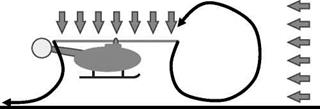Brownout
As the helicopter approaches the ground, the spreading wake will interact with any horizontal wind. This will tend to turn the upwind wake upwards after which it re-enters the rotor. This sets up a type of toroidal flow. The effect is shown schematically in Figure 2.33.
A considerable amount of research has been devoted to this effect, for the reason that when the helicopter is operating where the ground surface is easily raised into the air [13-15]. A cloud of ground debris is entrained by the interacting flows surrounding the aircraft. Visibility is severely restricted making operations very hazardous. Figure 2.34 shows a V22 descending into a cloud of dust caused by the downwash from the rotors.
|
|
|
Figure 2.34 V22 descending into a brownout cloud (Courtesy Eglin Air Force Base) |
References
1. Glauert, H. (1937) The Elements of Aerofoil and Airscrew Theory, Cambridge University Press.
2. Gustafson, F. B. and Gessow, A.(1945) Flight tests on the Sikorsky HNS-1 (Army YR-4B) helicopter, NACA MR L5D09a.
3. Gessow, A. (1948) Effect of rotor blade twist and planform taper on helicopter hovering performance, NACA Technical Notice 1542.
4. Brotherhood, P. and Stewart, W. (1949) An experimental investigation of the flow through a helicopter rotor in forward flight, ARC R&M 2734.
5. Castles, W. Jr and Gray, R. B. (1951) Empirical relation between induced velocity, thrust and rate of descent of a helicopter rotor as determined by wind tunnel tests on four model rotors, NACA TN 2474, October.
6. Jones, J. P. (1973) The rotor and its future. Aero. J., 751,77.
7. Gray, R. B. (1956) An aerodynamic analysis of a single-bladed rotor in hovering and low speed forward flight as determined from smoke studies of the vorticity distribution in the wake, Princeton University Aeronautical Engineering Report 356.
8. Landgrebe, A. J. (1972) The wake geometry of a hovering helicopter rotor and its influence on rotor performance. JAHS, 17(4), 3-15.
9. Landgrebe, A. J. (1971) Analytical and experimental investigation of helicopter rotor hover performance and wake geometry characteristics, USAAMRDL Technical Report, 71-24.
10. Clark, D. R. and Leiper, A. C. (1970) The free wake analysis – a method for the prediction of helicopter rotor hovering performance. JAHS, 15(1), 3-12.
11. Knight, M. and Hafner, R. A. (1941) Analysis of ground effect on the lifting airscrew, NACATN 835.
12. Cheeseman, I. C. and Bennett, W. E. (1955) The effect of the ground on a helicopter rotor, ARC R & M 3021.
13. Phillips, C., Kim, H. W. and Brown, R. E. (2009) The effect of rotor design on the fluid dynamics of helicopter brownout. 35th European Rotorcraft Forum, Hamburg, September.
14. Phillips, C., Kim, H. W. and Brown, R. E. (2010) Helicopter brownout – can it be modelled? RAeS Rotorcraft Group Conference ‘Operating Helicopters Safely in a Degraded Visual Environment’, London, June.
15. Phillips, C., Kim, H. W. and Brown, R. E. (2010) The flow physics of helicopter brownout. 66th American Helicopter Society Annual Forum, Phoenix, AZ, May.













